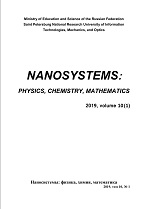|
This article is cited in 3 scientific papers (total in 3 papers)
PHYSICS
Near-field optical microscopy of surface plasmon polaritons excited by silicon nanoantenna
I. S. Sinev, F. E. Komissarenko, I. S. Mukhin, M. I. Petrov, I. V. Iorsh, P. A. Belov, A. K. Samusev
St. Petersburg National Research University of Information Technologies,
Mechanics and Optics,
Kronverkskiy, 49, St. Petersburg, 197101, Russia
Abstract:
An optical nanoantenna is a device that transforms far-field electromagnetic radiation into near-field and vice versa. Naturally, it can serve as a conduit between free space light and localized optical modes, including surface waves. With the recent rise of all-dielectric nanophotonics, nanoantennas made of high-index materials were found to offer unparalleled means for manipulation of light due to presence of equally strong electric and magnetic responses in the visible spectral range. Here, we demonstrate excitation of surface plasmon polaritons by single silicon nanosphere on gold layer measured by means of scanning near-field optical microscopy. The interference patterns observed in the measured near-field maps allow us to retrieve information on directivity and relative excitation efficiency of surface plasmon polariton in the longer wavelength part of the visible spectral range. Our results demonstrate that all-dielectric nanoantennas could prove to be a valuable tool for controlling directivity and efficiency of excitation of surface waves.
Keywords:
near-field optical microscopy, silicon nanoparticles, all-dielectric nanoantennas, surface plasmon polaritons.
Received: 13.09.2018
Citation:
I. S. Sinev, F. E. Komissarenko, I. S. Mukhin, M. I. Petrov, I. V. Iorsh, P. A. Belov, A. K. Samusev, “Near-field optical microscopy of surface plasmon polaritons excited by silicon nanoantenna”, Nanosystems: Physics, Chemistry, Mathematics, 9:5 (2018), 609–613
Linking options:
https://www.mathnet.ru/eng/nano350 https://www.mathnet.ru/eng/nano/v9/i5/p609
|

|




 Contact us:
Contact us: Terms of Use
Terms of Use
 Registration to the website
Registration to the website Logotypes
Logotypes








 Citation in format
Citation in format 
